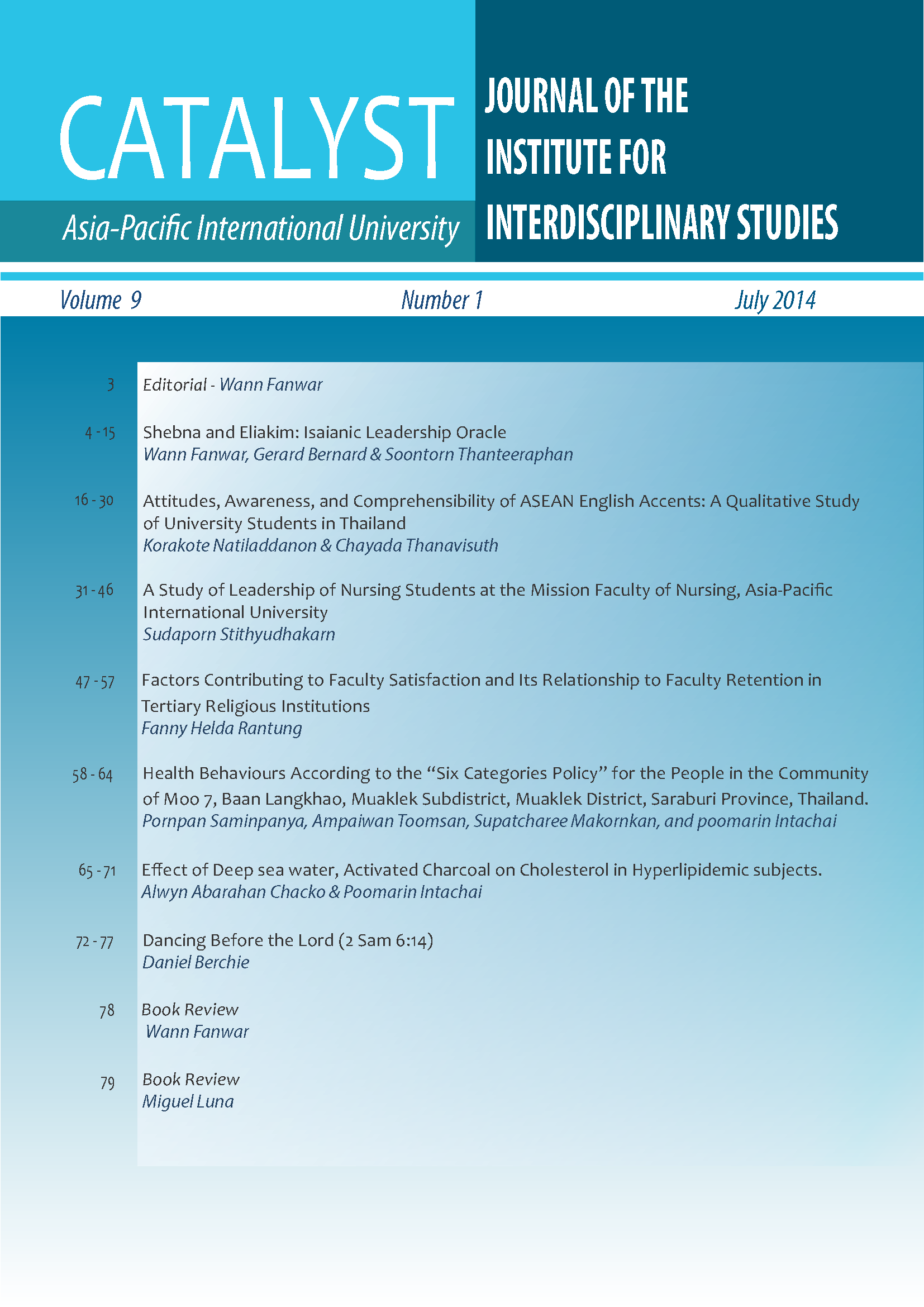A Study of Leadership of Nursing Students at the Mission Faculty of Nursing, Asia-Pacific International University
Main Article Content
Abstract
Assessment of leadership competence is important in planning for self-development among nursing students. The purpose of this study was to study the leadership competence of nursing students at the Mission Faculty of Nursing, Asia-Pacific International University. The subjects consisted of 75 fourth year nursing students. The research instrument was a questionnaire, which had a content validity and the reliability of .93. Data were analyzed using descriptive statistics. Results showed that the mean score of leadership among nursing students was high (X=3.55, S.D. = 0.98). Specifically, Ethical competency (X=3.82, S.D.=1.11), Professional competencies (X=3.73, S.D.=0.94), Management competency (X=3.64, S.D.=0.91), and Political economic and social competencies (X=3.79, S.D.=1.08) were high. On the contrary, Personal competency (X=3.15, S.D.=0.98), Knowledge and Intelligence competencies (X=3.30, S.D. =0.79) and uses of technology and foreign language competencies (X=3.46, S.D. =1.03) were moderate. The results from this study could be used as preliminary information for teachers of the Nursing Leadership Course to improve teaching-learning methods by enhancing students’ conceptual and systematic thinking as a leader which will lead to success when working.
Article Details

This work is licensed under a Creative Commons Attribution-NonCommercial-NoDerivatives 4.0 International License.
Copyright: Asia-Pacific International University reserve exclusive rights to publish, reproduce and distribute the manuscript and all contents therein.
References
Anthony, M.K., Standing, T., Glick, J., et al. (2005). Leadership and nurse retention: the pivotal role of nurse managers. Journal of Nursing Administration, 35, 146-155.
Antrobus, S., & Kitson, A. (1999). Nursing leadership: Influencing and shaping health policy and nursing practice. Journal of Advanced Nursing, 29, 746-753.
Badzek, L. (2008). Guide to the code of ethics for nurses: Interpretation and application. Silver Springs. Maryland: American Nurses Association.
Bower, F.L. (2000). Nurses taking the lead: Personal guidelines of effective leadership. Philadelphia: W.B. Sanders Company.
Cohen, S. (2007). The image of nursing: How do others see us? How do we see ourselves. American Nursing Today, 2(5), 24-26.
Cummings, G., Lee, H., MacGregor, T., Davey, M., Wong, C., Paul, L., Stafford, E. (2008). Factors contributing to nursing leadership: a systemic review. Journal Health Services Research and Policy, 13(4), 240-248.
Curtis, E.A., Vries, J.D., Sheerin, F.K. (2011). Developing leadership in nursing: exploring core factors. British Journal of Nursing, 20(5), 306-309.
Duygulu, S., Hicdurmaz, D., and Akyar, I. (2011). Nursing students’ leadership and emotional intelligence in Turkey. Journal of Nursing Education, 50(5), 281-285.
Fagin, C.M. (2000). Essays on nursing leadership. New York, NY: Springer Publishing.
Hawkins, C. (2009). Leadership theories-managing practices, challenges, suggestion. The Community College Enterprise, 15(2), 39-62.
Hoffman, S., Harris, A. & Rosenfeld, D. (2008). Why mentorship matters: Students, staff and sustainability in inter-professional education. Journal of Inter-professional Care, 22(1), 103-105.
Jaruwatcharapanitku, A., Limkosit, Y., Lertpoonvilaikul, W., and Boonchong, P. (2008). Effect of Nursing skill improvement to perceived of self-competency in fundamental clinical practice.Nursing Journal, 39(2), 10-18.
Kelly, K. (2007). From apathy to political activism. American Nursing Today, 2(8), 55-56.
Kleinman, C. (2004). Leadership: a key strategy in staff nurse retention. Journal of Continuing Education Nursing, 35; 128-132.
Lapidus-Graham, J. (2012). The lived experience of participation in student nursing associations and leadership behaviors: A phenomenological study. Journal of the New York State Nurses Association. 43(1), 4-12.
Laschinger, H.K.S., Wong, C., Ritchie, J. et al. (2008). A profile of the structure and impact of nursing management in Canadian hospitals. Health Quarterly, 11, 85-94.
Lockewood-Rayermann, S. (2003). Preceptors, leadership style and the student practicum experience. Nurse Educator, 28(6), 247-249.
McClure, M. & Hinshaw, A. (2007). What makes a hospital “magnetic?” Spotlight on nurse staffing, autonomy, and control over practice. American Nurse Today, 2(4), 15-17.
Patton, R. (2007). Save one life you’re a hero, save 10,000 lives you’re a nurse. The American Nurse, 39(3), 3.
Phothidara, W. (2011). Nursing education management: For student generation Y. Journal of Nursing Science & Health, 34(2), April-June, 60-69.
Pullen, M.I. (2003). Developing clinical leadership skills in student nurses. Nurse Education Today, 23, 34-39.
Smith, S.L., Manfredi, T., Hagons, O, Drummond-Huth, B., Moore, P.D. (2006). Application of the clinical nurse leader role in an acute care delivery model. Journal of Nursing Administration, 36, 29-33.
Spector, P.E. (2006). Industrial and Organizational Psychology: Research and Practice. 4th edn. John Wiley & Sons, New Jersey.
Srisudta, S. (2004). Knowing of Information technology of nursing student in Faculty of Nursing, Khonkhan University. Journal of Libraries and Information Technology Knonkhan University , 22(3), 1-22.
Sullivan, E.J. & Garland, G. (2010). Practical Leadership and Management in Nursing. Harlow: Pearson Education Limited.
Thinkarn, W. (1997). A study of leadership skill in graduated nursing. Master degree thesis in nursing education. Chulalongkorn University.
Tourangeau, A.E. (2003). Building nurse leader capacity. Journal of Nursing Administration, 33, 624-626.
Tunajek, S. (2006). Professional standards and public accountability. AANA Journal, 74(1), 25-26.
Weingarten, C. (2008). Learning leadership through the student nurses association. The Pennsylvania Nurse, 63(1), 19-21.


